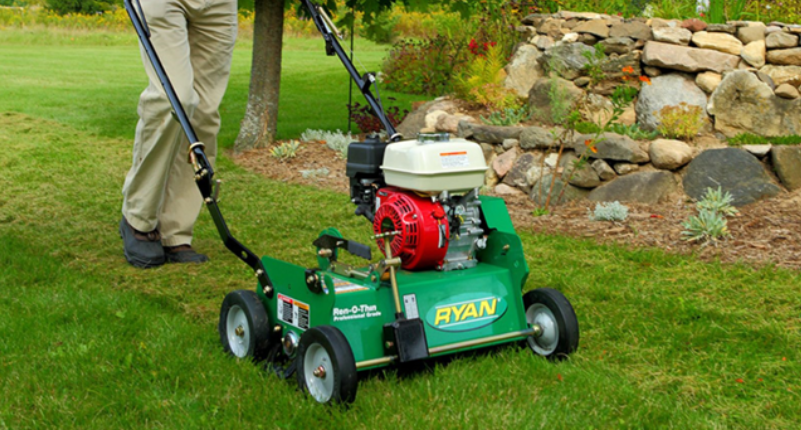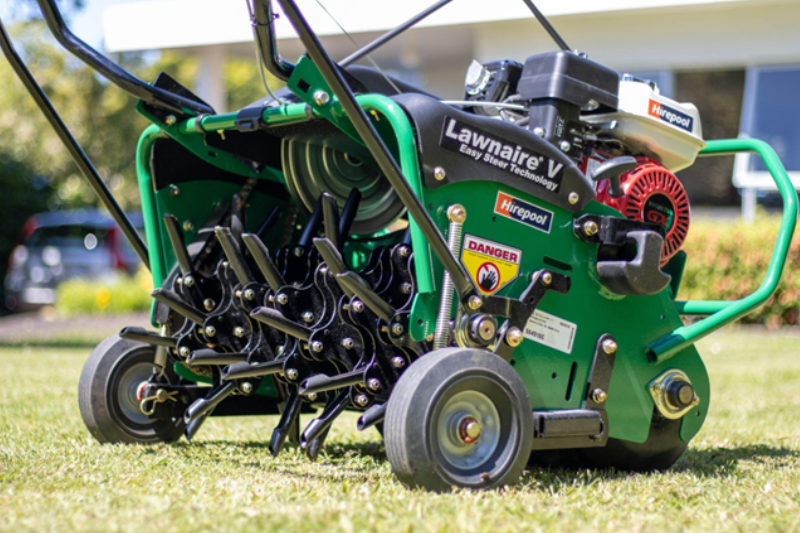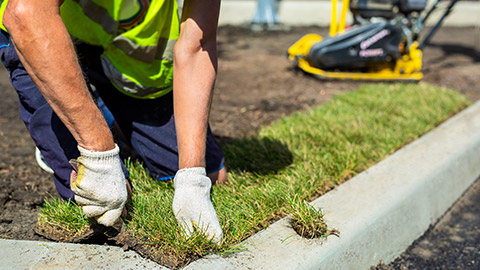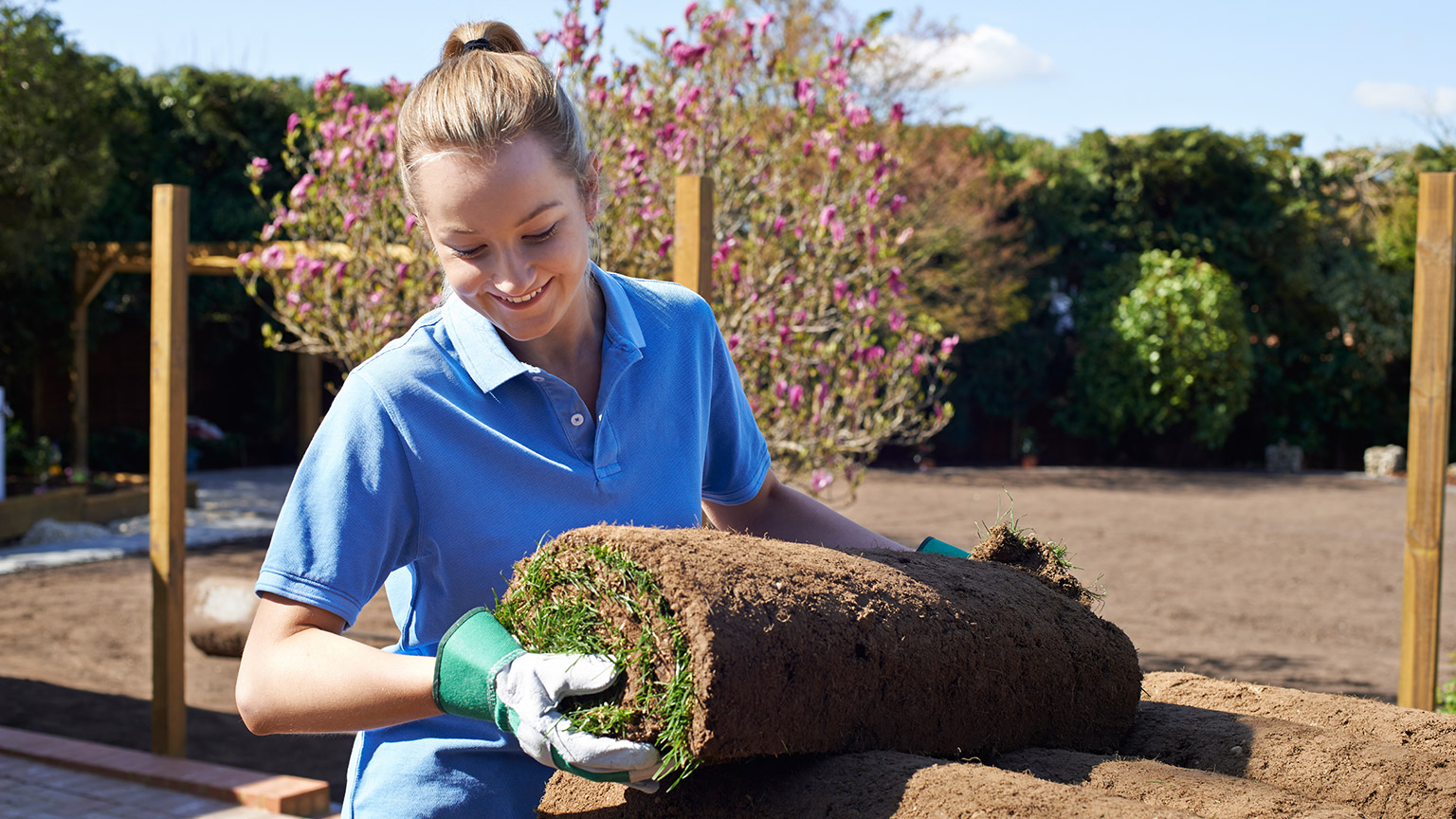In this topic we’ll investigate common lawn problems and their solutions and go on to demonstrate how to establish a new lawn from seed and by using rolled turf.
By the end of this topic you’ll be able to:
- trouble-shoot lawn problems
- decide on which lawn replacement option is right for you
- prepare the base
- lay rolled turf
- sow a lawn from seed
- take care of the turf during the establishment phase.
There are a few reasons why you may be planning on establishing a new lawn.
It could be that you need to change the contours to fit in with the rest of your landscape design.
Alternatively, your current lawn might be in a bad state so you want to start again. If this sounds like you, we strongly recommend you first consider why the lawn may be looking bad. Sometimes you can revitalise an old lawn and make it look good with less effort and time than establishing (often called renovating) a new lawn.
Click on the following headings to learn about the most common turf disorders:
The most common reason for lawns to turn brown in Aotearoa during summer is as a result of drought stress and dormancy. If it feels dry, watering should help, in most cases. Make sure you follow any water restrictions that are in place.
Weeds are plants that grow where they aren’t wanted. Lawn weeds are excellent at filling gaps so often they will take over when the health of turf grasses decline and leave bare soil.
- Grasses will struggle (and weeds may take over) when:
- the soil is too dry or too wet
- the soil is lacking in plant-available nutrients
- the lawn is mown too short
- the lawn doesn’t get enough sun
- the soil is too acidic (How do I treat a lawn that is more weeds than grass?, no date; Lutz, 2024).
If patches of your lawn have turned brown it could be for any of the following reasons:
- over watering
- soil compaction or buried waste
- dog urine
- scalping, which is caused by mowing the grass too short
- applying too much fertiliser (Why Is My Lawn Turning Brown?, 2023).
“There could be several reasons for your lawn yellowing, it will be a process of elimination. Poor drainage can cause yellowing, this can be caused by heavy clay soil or not enough topsoil on top of a clay base, which is quite common in new subdivisions. Add organic matter to the soil, either by applying a fine layer of compost or Tui Lawn Preparation mix over the area. Organic matter will help improve soil structure as well as improving water retention in summer and make fertiliser applications more effective. If drainage is poor, you can aerate the soil with spikes tied on to shoes (purchased from hardware stores) to open up the soil structure. Another reason for lawns to yellow is grass grub, if the grass is yellowing and there is dead grass on the soil surface, as well as birds like starlings feeding on the lawn, then it is possible you have grass grub. To find out if you do have grass grub, dig a square to a spade depth and turn the sod over, you should see grass grub if it is present. If you suspect grass grub talk to your local garden centre of hardware store for a suitable control. It could be the colder temperatures [resulting in frosts that damage the turf, or] …your lawn needs feeding [fertilising].” (Why is my lawn yellowing?, no date)
This is most likely caused by blunt mower blades, leading to the leaves being shredded rather than cut cleanly.
Soil tests
Conducting a few simple tests will help you work out what’s wrong with your soil.
Soil texture test
Earlier in the programme we demonstrated how to work out the texture of a soil by doing a soil texture test in the field. Here is that video again, in case you need a reminder.
Watch
How to test your soil - texture (sand, silt, clay composition)
Duration: 3:39 minutes
In this video Neroli Brennan of Central West Local Land Services shows how to do a soil texture test in the field.
While you’ve got a test pit, feel the soil at different depths to see how dry it is. If there is moisture in the soil, but it is deeper than the roots of the grass, the turf won’t be able to absorb it.
If water isn’t moving through the soil at a reasonable rate you have a drainage problem. This could be caused by:
- thatch buildup
- soil compaction
- being a heavy clay soil
- too much organic matter in the soil
- dry patch – this is a condition where the soil gets an oily surface which prevents water from entering the soil.
Also have a look at the sides of the test pit and the soil you’ve dug out. How easily does it break apart? Are there visible cracks and air pockets in the soil? If it holds together as a solid clump and there are no cracks or pore spaces visible it is likely that the soil is compacted.
Soil pH
There are two ways to test the pH of your soil:
- Send a sample away to a lab for testing
- Use a soil pH test kit to test in the field.
A lab test result will be more accurate but costs more and takes time to get a result back. A field test is less accurate – it usually gives a reading that is rounded to a whole number, e.g. pH of 6 – but is quick.
Watch
How to test soil pH
Duration: 4:17 minutes
Watch the following video by the New South Wales Government, which shows how to test the pH of your soil.
In this video Neroli Brennan of Central West Local Land Services shows how to use a pH field test.
“Low pH means acidic conditions and high pH indicates alkaline conditions. If the pH is too high, your grass cannot properly absorb nutrients. Ideal pH should be between 6.5-7.0, slightly acidic” (Beyond Pesticides, no date).
Test sets differ, so make sure you follow the instructions for the test set you use. Lab testing is outside the scope of this programme.
Problems: meet solutions
By now you should have a reasonable idea of what problems your lawn faces. Let’s take a look at some common solutions.
Soil compaction
If your soil is heavily compacted, you can aerate it by hiring a corer or aerator, or engaging a lawn care expert to aerate your soil.
Once the lawn has been aerated, brush coarse sand into the holes.
Poor drainage
If you have a lot of thatch (partially decomposed plant matter) on top of the soil, it is a good idea to remove as much as you can. The most effective way to do this is by hiring a scarifier or engaging a lawn care expert to scarify the lawn.
Once the lawn has been scarified, use a mower with a catcher to collect and remove the thatch.
After scarification it is common practise to fertilise, lightly overseed and brush in a sand soil mixture then keep the soil moist by irrigating it for a few days.

This scarifier lifts thatch off the ground and leaves it on top of the lawn, ready to be collected by a mower with a catcher.
If the poor drainage is caused by soil compaction, aerate the soil, as described above. This and scarification will also help to reduce the amount of organic matter in the soil.

This hollow-tine corer is effective at removing organic matter, creating channels for water ingress, and decompacting the soil.
Soil that is low in nutrients
If you think that your soil is low in nutrients, apply a lawn fertiliser.
Soil that is too acidic
Add lime to raise soil pH (make it less acidic).
As a general rule, don’t apply more than 22kg of lime for each 100m2 of lawn in a single application. If you need to apply more, wait for three months before reapplying.
To raise the pH of soil by 1.0, for every 100m2 of lawn apply:
- Sand: 11kg
- Silt: 34kg (two applications of 17kg)
- Clay: 44kg (two application of 22kg)
Soil that is too dry
Water your lawn “every 3 to 7 days for between 60-90 minutes a time. Or alternatively, you could let your grass enter into its summer dormancy state, knowing that it will return to normal once normal temperatures resume. [You only need to start] worrying about dead grass… when temperatures start to reach highs of over 29°C for 3 consecutive weeks without any rain.” (Why Is My Lawn Turning Brown?, 2023)
If dry patch is an issue, speak to your landscape products supplier for a recommendation about what product to apply.
Turf scalping
Turf scalping is caused by having your mower set too low. To prevent scalping, increase your mowing height.
Turf shredding
Turf shredding is caused by blunt mower blades. Have your mower blades sharpened.

The shredded tips of this grass have been caused by blunt mower blades.
It is also worth thinking about these problems because a new lawn can quickly deteriorate if it is not maintained correctly. In other words, if you still intend to spend the time and money establishing a new lawn, make sure that it will be looked after.
If you’ve decided that putting down a new lawn is still the best way to go, your two main options are:
- laying rolled turf
- establishing from seed.
When deciding which option to go for, it is common to think that rolled turf is the easiest. However, even though it’s often referred to as instant turf, it requires as much preparation and nearly as much care during establishment as growing a lawn from seed. And it is far more expensive than establishing from seed.
The best times to put down a new lawn are spring and autumn.
Complete this quiz to learn more about the advantages and disadvantages of these options. See if you can guess if the statements apply to rolled turf, lawn established from seed, or both.
Cool season and warm season grasses
If you’ve seen any lawn care videos on YouTube, you’ve probably seen ones from Australia and the United States. The grasses most commonly grown in Australia and the southern half of the US are warm season grasses. These grasses look dense, with spiky leaves.
In Aotearoa, warm season grasses typically grow year-round in Tamaki Makaurau Auckland and Te Tai Tokerau Northland. They also grow in coastal areas of Te Ika a Maui the North Island.
Everywhere else, cool season grasses are most suited to the climate. The following are the most commonly used grasses for ornamental (primary) lawns in Aotearoa:
- Common cool season grasses
- Browntop (Agrostis capillaris)
- Fescue (Festuca spp.)
- Ryegrass (Lolium spp.)
- Common warm season grasses
- Couch (Cynodon dactylon) – pronounced cooch, also known as Bermuda grass
- Kikuyu (Cenchrus clandestinus, syn. Pennisetum clandestinum)
There is a scientific difference between warm season and cool season grasses, but we won’t get into this here.
Whether establishing a new lawn from seed or rolled turf, having a good base is essential. Watch the first 2:30 of this video by Readylawn NZ to see how to prepare the base.
Watch
How to lay Readylawn
Duration: 7:56 – watch the first 2:30 minutes
This video shows clearly how to prepare a base ready for sowing with lawn seed or laying rolled turf.
In the video, the team has already removed the sod using a turf cutter. Sod is the term given to the turf and the top layer of soil. An alternative approach is to spray the grass and weeds with a broad spectrum herbicide and then remove the dead grass and weeds using a scarifier after a few weeks. This approach is shown later in this topic.
The following notes relate to the video:
- Take all the time you need to get the contours right. Keep in mind that if you are laying rolled turf it comes in soil that is already 10-20mm thick. You are better off to have the finished level too low than too high. If it is too low you can slowly bring the level up by topdressing it with clean, weed-free, screed soil or sand in thin layers over a number of months.
- If the soil is wet, using a roller can cause soil to clump and get stuck to the roller so the “heeling” approach is preferred at least for small jobs.
It's a good idea to prepare the base right before you sow the lawn or install the rolled turf. Have the seed ready or the turf rolled booked for delivery within a day or two of finishing base preparation.

Now that you’ve prepared the base it’s time to install the turf rolls.
Rolled turf has led a charmed life up until the point it is cut and rolled and sent to your site. It has been carefully watered, fertilised, and sprayed to kill off any weeds and prevent damage by pests and diseases.
In order for it to thrive at your site, you need to ensure that it:
- has a well prepared base to sit on and send roots down into
- is laid properly
- is cared for while the turf plants establish their roots
- is cared for longer-term by ensuring it has enough water, nutrients, sunlight and is protected from weeds, insect pests, and diseases.
This short video by Lawn Solutions Australia gives a good summary of the installation process.
Watch
How to install a new lawn
Duration: 1:45 minutes
This video briefly introduces the key steps involved in laying rolled turf.
Now that you know the key steps, watch the rest of this video by Readylawn NZ, from 2:30 onwards, for a more detailed walkthrough.
Watch
How to lay Readylawn
Duration: 7:56 – watch from 2:30 onwards
This video shows the steps involved in laying rolled turf to give it the best chance of survival.
The following notes relate to the video:
- When dealing with the tightly rolled end, you may need to roll it the opposite way so that it will sit flat.
- When laid, add lawn mix soil along the edges and joints if any small gaps form while you are laying the turf.
Establishing healthy turf from rolls
Once the turf is laid it's essential that you take good care of it until the roots are well established; typically the first four weeks.
The following video by Lawn Solutions Australia provides a good summary of the activities you should carry out during establishment.
Watch
How to care for a new lawn | Watering, Mowing & Fertilising
Duration: 3:28 minutes
This video gives good advice about how to care for your newly laid turf for the first four weeks or so, until the roots have established.
Now that you’ve prepared the base it’s time to sow your new lawn.
Watch
How To Grow A Lawn From Grass Seed (before & after)
Duration: 12:22 minutes
In this video, Matt from the Garden Lawncare Guy YouTube channel establishes a new lawn from seed.
The term overseed means to drop seeds onto the soil. This is different to seed drilling which injects the seeds into holes in the soil. When overseeding it is important to rake the soil lightly after you have applied the seeds to help cover them with soil.
The following notes relate to the video:
- To know how much seed and fertiliser you’ll need, measure the area.
- Apply seed and fertiliser at the rates specified by the manufacturer.
- A broadcast spreader, like the one shown in the video, is useful for large areas but it is also possible to spread seeds and fertiliser by hand. Grab a handful and flick it horizontally, as shown in the video in the rolled turf section, above. Keep in mind though, that using a spreader will help ensure you are applying the product evenly. Handheld broadcast spreaders, like the one below, are reasonably cheap to buy.
- In the video, Matt talks about levelling the lawn, but in reality the lawn has a slope to it. Technically, levelling is about making a surface perfectly horizontal, whereas what he is doing here is smoothing to remove humps and dips.
- The finished level of the base appears to be about 20mm below the level of the sleepers. It would have been better to bring this up so it’s only 5mm below the top of the sleepers.
- Earlier we mentioned that using a roller on moist soil can lead to the soil and seed clumping on the roller, and this is shown in this video. It would have been a better idea to heel the soil instead.

A handheld rotary spreader is a worthwhile investment.
Establishing healthy turf grown from seed
Once you seeded the lawn and started irrigating it, it’s time to sit back and wait for the seeds to germinate. Make sure to keep the soil moist at all times for the first three weeks or so.
If you spot some weeds coming up, don’t worry. It’s more important that you give the turf surface and the soil a chance to establish. You can start weed control after a few months have passed and the turf grass is more robust.
When the lawn is thick and has reached a height of 100mm, it could be time to mow. Check that the grass plants are well rooted; they shouldn’t pull out easily when you tug on them.
Follow these guidelines when mowing a new lawn:
- Mow on the highest setting the first time around.
- Use a walk-behind mower and take care not to rough up the soil.
- Make sure the mower blades are sharp and that you run the mower with the highest blade speed possible. This is usually controlled by the engine speed.
- Push the mower slowly while you work. Empty the catcher frequently. Don’t let it fill up. Try to empty it before it gets half full.
- Mow again 3-7 days later, with the mower dropped down one notch.
- Keep lowering the mower each time you mow until it is at your desired mowing height.
After 2-3 months, spray the lawn with weed and feed. Weed and feed is the term for a product that contains both a selective herbicide to kill weeds and fertiliser to boost grass growth. There are plenty of different brands of weed and feed which generally work in the same way.
Water lawns during summer when the soil is dry to touch, to help prevent them browning off and becoming dormant. To get the most out of your irrigation you might want to apply a penetrant wetting agent to the turf and soil. “Penetrant wetting agents effectively work by making water wetter! It means each water droplet spreads more easily and can penetrate soils more readily.” (Wetting Agent Technology, 2016)
That’s it!
Now you know how to:
- trouble-shoot lawn problems
- decide on which lawn replacement option is right for you
- prepare the base
- lay rolled turf
- sow a lawn from seed
- take care of the turf while it establishes.
Assessment 3
If you’ve chosen to establish a lawn for your soft landscaping feature, you should be ready to make a start.
Head over to the assessments section and read the full assessment requirements in detail. If you have any questions, contact your tutor.
